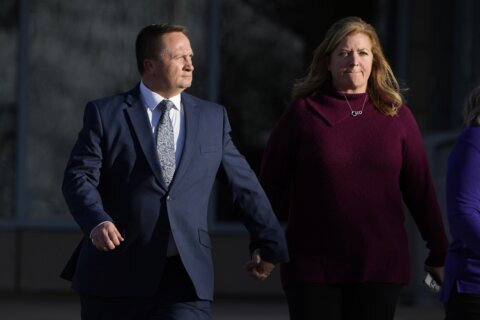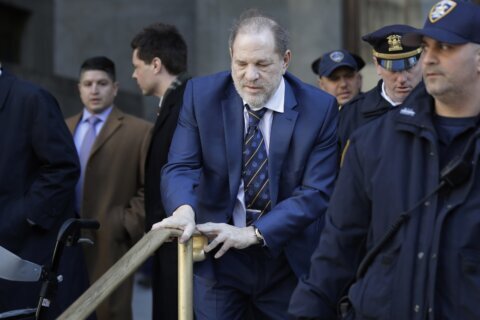SAN DIEGO (AP) — A key witness in the Navy’s case against a junior sailor accused of setting the fire that destroyed a U.S. warship last year testified Tuesday that he is certain that he saw the suspect in the area where the flames ignited, but acknowledged changing the account he initially told investigators.
Petty Officer 3rd Class Kenji Velasco blamed his nervousness for the changes to his story and said in military court during a preliminary hearing that he was now “100 percent” sure that he saw the suspect, Ryan Sawyer Mays, descend to the ship’s lower vehicle storage area on the day of the fire. Mays, 20, was a seaman apprentice at the time and has since been promoted to seaman.
Another sailor, Carissa Tubman, who was assigned to escorting Mays to the brig on Aug. 20, 2020, testified that she heard a stunned Mays mumble to himself: “I’m guilty, I guess. I did it.” Then she said he mumbled some more before she heard him say: “It had to be done.”
Defense attorneys said he was joking and speaking sarcastically after being surprised that he was being locked up.
Mays has denied igniting the blaze that burned for nearly five days on the USS Bonhomme Richard in July 2020, injuring dozens of personnel aboard and sending acrid smoke wafting over San Diego. It marked one of the worst noncombat warship disasters in recent memory. The amphibious assault ship was damaged so badly that it had to be scuttled.
Mays is charged with aggravated arson and the willful hazarding of a vessel. The hearing that started Monday is expected to wrap up Wednesday when the defense is expected to call its witnesses to the stand. The hearing will determine whether there is enough evidence for the case to proceed to a military trial.
Defense attorneys challenged several of the government’s witnesses about their accounts given to investigators a year ago, after several of them recalled details differently or not at all during the hearing.
About 160 sailors and officers were on board when the fire started on the 840-foot (256-meter) vessel, which had been docked at Naval Base San Diego while undergoing a two-year, $250 million upgrade.
Investigators concluded that cardboard boxes in the lower vehicle storage were ignited, and the blaze rapidly spread in the area cluttered with forklifts, hoses, pallets, and other equipment used by contractors.
Officials assessing the ship’s damage found three of four fire stations on the ship had evidence of tampering: Fire hoses had been disconnected and one was cut, according to court documents.
Defense attorney Gary Barthel said thousands of contractors were coming and going from the ship at the time. Some were caught smoking on board in violation of the rules, and there was a problem with brass parts being stolen, and contractors cutting hoses.
Barthel said there was a roster with 12,000 contractors but “there was no way to monitor who went on and off the ship.”
Navy prosecutors have alleged that Mays did it because he was “disgruntled” after dropping out of Navy SEAL training on the fifth day and being assigned to the ship’s deck duty, which largely involved cleaning the vessel.
Velasco and two other sailors, including his superior, testified Tuesday that Mays was combative, disrespectful and had a poor attitude.
Mays’ lawyers grilled Velasco about not naming Mays as the person he saw until more than a week after the fire. Initially, Velasco told investigators he did not recognize the person he saw that morning and said whoever did it did not belong to his deck department, which Mays did.
Velasco also contradicted himself about whether he saw Mays directly or from the side and about what time he saw Mays descend to the area.
He agreed with a defense attorney that he was told by investigators at one point “you just keep flip flopping around” so they did not know what had happened.
But Velasco said things became more clear in his mind after he thought about them more.
“I just wanted to make sure it was him that I saw,” Velasco said.
Mays has insisted he was on the ship’s hangar bay when the fire started. Mays attorneys said no physical evidence ties Mays to the crime, and they said at least one other sailor saw another person run out of the lower area that morning.
Investigators said they looked into him and were able to verify that he had left base before the fire started. They said they also did background checks and interviewed scores of contractors.
Federal investigator Al Porter said Mays stood out for his hatred of the fleet and his desire to get back to SEAL training.
“I was kind of shocked at how descriptive he was about his disdain for it (the Navy),” he said.
Porter, a former SEAL, said he caught Mays in lies while interviewing him Aug. 20, including exaggerating his SEAL training experience.
Mays told him the ramp was the only way out of the lower area, though later when he toured the charred ship with Porter and another investigator he admitted he had used a ladder in a well to get out of the area. The investigators had found the hatch to the well had been left open after the fire, indicating someone had gone through there to escape unnoticed.
After Mays was interviewed by investigators, the command ordered him to the brig.
More than 60 sailors and civilians were treated for minor injuries, heat exhaustion and smoke inhalation.
Dozens of Navy officials, including several admirals, face disciplinary action for systematic failures that investigators said prevented the blaze from being put out sooner, according to investigators.
Copyright © 2024 The Associated Press. All rights reserved. This material may not be published, broadcast, written or redistributed.







